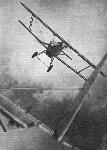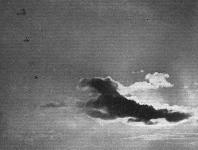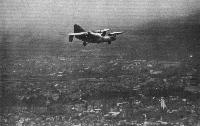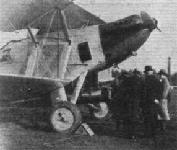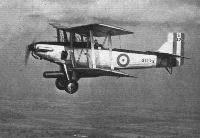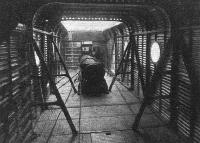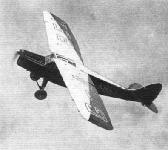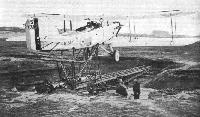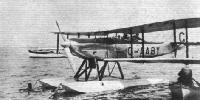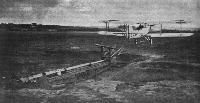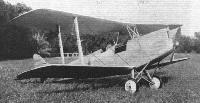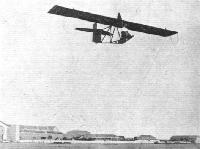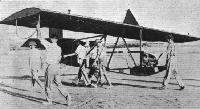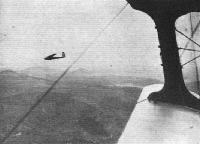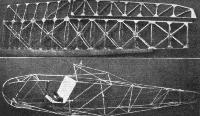Фотографии
-
AS THE REAR GUNNER SEES IT: The Hawker Fleet Fighter with Rolls-Royce F.MS engine photographed from a Hawker "Hart." Mr. Bulman was piloting the "Hart," and the single setter was piloted by Mr. Sayer. Note that the two machines were making a turn, simulating a flight in which the two-seater is endeavouring to prevent the single-seater from getting "on its tail."
Самолёты на фотографии: Fairey Fox - Великобритания - 1925Hawker Demon - Великобритания - 1932Hawker Hart - Великобритания - 1928
-
No. 33 Bombing Squadron: Hawker "Harts" (Rolls-Royce engines) in flights abreast.
Самолёты на фотографии: Hawker Hart - Великобритания - 1928
-
SCALE MODELS: Four realistic scale models made by Mr. D. M. Dent from cardboard and other "oddments." One of they is - Bristol "Bulldog"
Самолёты на фотографии: Bristol Bulldog - Великобритания - 1927
-
Регистрационный номер: N247 SCALE MODELS: Four realistic scale models made by Mr. D. M. Dent from cardboard and other "oddments." One of they is - Supermarine "S.6"
Самолёты на фотографии: Supermarine S.5 / S.6 - Великобритания - 1927
-
THE "PRINCE OF WALES FEATHERS": Siskins of No. 43 Squadron, commanded by Sq.-Ldr. C. N. Lowe, breaking the cords with which they were tied together during the earlier part of their display of formation flying.
Самолёты на фотографии: Armstrong Whitworth Siskin - Великобритания - 1921
-
Регистрационный номер: OO-AGE [2] An unusual view: The Westland "Wessex" from below.
The tri-motor Westland Wessex OO-AGE which later became G-ADEW.Самолёты на фотографии: Westland Wessex / Westland IV - Великобритания - 1929
-
Регистрационный номер: OO-AGF Самолёты на фотографии: Westland Wessex / Westland IV - Великобритания - 1929
-
The Westland "Wessex" in flight, photographed from another Westland Aeroplane.
Самолёты на фотографии: Westland Wessex / Westland IV - Великобритания - 1929
-
Mounting etc. of the starboard "Genet Major" in the Westland "Wessex."
Самолёты на фотографии: Westland Wessex / Westland IV - Великобритания - 1929
-
IN COURSE OF CONSTRUCTION: This photograph of the fuselage of the "Wessex" gives a good idea of the structure, and also shows one of the outrigger mountings for the outboard engines.
Самолёты на фотографии: Westland Wessex / Westland IV - Великобритания - 1929
-
No steps required: The door of the Westland "Wessex" is low over the ground, and passengers step straight in.
Самолёты на фотографии: Westland Wessex / Westland IV - Великобритания - 1929
-
MODERNITY: On the Westland "Wessex" a tail wheel is used instead of the old-fashioned tail skid
Самолёты на фотографии: Westland Wessex / Westland IV - Великобритания - 1929
-
With the Cowling in place: Note the careful streamlining of the outboard engines
Самолёты на фотографии: Westland Wessex / Westland IV - Великобритания - 1929
-
Регистрационный номер: OO-AGE [2] Самолёты на фотографии: Westland Wessex / Westland IV - Великобритания - 1929
-
Westland Wessex 3 "Genet Major" Engines
Самолёты на фотографии: Westland Wessex / Westland IV - Великобритания - 1929
-
Mr. R. H. Wynne, Ground Engineer of the Cinque Ports Club, flying a club Moth (Cirrus II), photographed by a member of the Committee from another club machine. The Club markings on the fuselage are Royal blue, white and orange.
Самолёты на фотографии: De Havilland Moth / D.H.60 - Великобритания - 1925
-
Регистрационный номер: G-AACN The Handley Page "Gugnunc," the "Autogiro," and the Westland-Hill Pterodactyl formating at Croydon.
Самолёты на фотографии: Cierva/Avro C.19 - Великобритания - 1929Handley Page Gugnunc / H.P.39 - Великобритания - 1929Westland-Hill Pterodactyl - Великобритания - 1925
-
THE LATEST "SIDESTRAND": The engines are Bristol "Jupiter" X F's. Note the Townend rings.
Самолёты на фотографии: Boulton Paul Sidestrand / P.29 - Великобритания - 1926
-
AN INTERESTING EXPERIMENT: The Focke-Wulf Co. of Bremen recently completed a second "Ente" or "tail-first" machine, which has now passed its type tests and is said to fulfil all the claims made for it. With the tail first arrangement the machine is made proof against stalling and spinning, while the general arrangement is such that the machine cannot be turned over on the ground, so that the wheel brakes may be applied with full force.
Самолёты на фотографии: Focke-Wulf F 19 Ente - Германия - 1927
-
Delegates interested in the torpedo on the Blackburn-Napier "Ripon."
Самолёты на фотографии: Blackburn Ripon / T.5 - Великобритания - 1926
-
Регистрационный номер: S1272 [2] Самолёты на фотографии: Blackburn Ripon / T.5 - Великобритания - 1926
-
Регистрационный номер: S1272 [2] For a number of years the Blackburn company has made a specialised study of the requirements to be met in the design of torpedo-carrying aircraft. These photographs show the latest type to be produced, the "Ripon III," which is of all-metal construction and fitted with a Napier engine. Note that the ailerons are inter-connected with Handley Page leading-edge slots.
Самолёты на фотографии: Blackburn Ripon / T.5 - Великобритания - 1926
-
Регистрационный номер: G-ABBC THE SARO AMPHIBIAN FAMILY: On the left is the "Cutty Sark," in the centre the latest "Windhover," and on the right the "Cloud."
Самолёты на фотографии: Saunders-Roe Cloud / A.19 - Великобритания - 1930Saunders-Roe Cutty Sark / A.17 - Великобритания - 1929Saunders-Roe Windhover / A.21 - Великобритания - 1930
-
Самолёты на фотографии: Caudron C.230 / C.270 / Luciole - Франция - 1930
-
Caudron C.232 95 h.p. Renault Engine
Самолёты на фотографии: Caudron C.230 / C.270 / Luciole - Франция - 1930
-
Регистрационный номер: VH-UOU A JUNKERS FREIGHT CARRIER FOR NEW GUINEA: A Junkers G.31 monoplane recently supplied to Guinea Airways, Ltd., for the transport of heavy machinery etc. Standing in front of the machine is Mr. A. S. Cross, the company's Chief Pilot.
Самолёты на фотографии: Junkers G 31 - Германия - 1926
-
"TONS" OF ROOM: The interior of the Junkers G.31 freight carrier supplied to Guinea Airways, Ltd. Note method of anchoring the cargo, and the large hatch in roof.
Самолёты на фотографии: Junkers G 31 - Германия - 1926
-
Регистрационный номер: G-ABEL A flying view of Lady Drummond-Hay's Puss Moth (Gipsy III).
Самолёты на фотографии: De Havilland Puss Moth / D.H.80 - Великобритания - 1929
-
Lady Drummond-Hay, who is an active journalist, is here seen in her "Puss Moth" which has been specially fitted up to enable her to carry on her work in the air. Refinements include : - Handley Page slots, Brown turn indicator, Sperry artificial horizon, special seats, and a folding table opening across the passenger seat which can be used to hold a portable typewriter.
Самолёты на фотографии: De Havilland Puss Moth / D.H.80 - Великобритания - 1929
-
Регистрационный номер: G-ABCF [2] THE "SOUTHERN CROSS JNR.": Kingsford-Smith's Avro "Avian Sports" (de Havilland "Gipsy II" engine) on which he accomplished his record flight to Australia.
Самолёты на фотографии: Avro Avian / Type 594/616 - Великобритания - 1926
-
EXTRA TANKAGE: Two photographs, taken before the fuselage covering was put on, showing the installation of the extra large petrol tank, &c.
Самолёты на фотографии: Avro Avian / Type 594/616 - Великобритания - 1926
-
Регистрационный номер: G-ABCF [2] COCKPIT AND NOSE OF THE LONG-RANGE "AVIAN": Extra fuel tanks were fitted, giving a duration of about 20 hours.
Самолёты на фотографии: Avro Avian / Type 594/616 - Великобритания - 1926
-
PIONEERING THE FLIGHT: The instrument board of Kingsford-Smith's "Avian."
Самолёты на фотографии: Avro Avian / Type 594/616 - Великобритания - 1926
-
Avro Long Range "Avian" Gipsy II Engine
Самолёты на фотографии: Avro Avian / Type 594/616 - Великобритания - 1926
-
Регистрационный номер: G-ABEF [2] Самолёты на фотографии: Ford Tri-Motor / 4-AT / 5-AT - США - 1926
-
THE AMERICAN WAY OF STARTING: Three men swinging the inertia starter on the Ford monoplane, one holding the end of the starting handle and the other two "cranking."
Самолёты на фотографии: Ford Tri-Motor / 4-AT / 5-AT - США - 1926
-
Регистрационный номер: G-AAZF, G-ABEF [2], ZK-ACG THE FORD TYPE 4-AT-E: Fitted with three Wright J.6 "Whirlwind" engines this machine carries 11 passengers and 2 pilots. Standing under the wings of the Ford are two Comper "Swifts," that on the left being the "Scorpion" version, while that on the right has a Pobjoy engine.
Ford 4-AT-E G-ABEF was assembled at Hooton by Compers in October 1930, and is seen here in company with Swifts ZK-ACG and G-AAZF.Самолёты на фотографии: Comper Swift / CLA.7 - Великобритания - 1930Ford Tri-Motor / 4-AT / 5-AT - США - 1926
-
Регистрационный номер: G-AAXP A. MODERN TYPE: The Segrave-Meteor, which will shortly be marketed both here and on the Continent on a large scale.
Самолёты на фотографии: Blackburn Segrave Meteor / B-1 - Великобритания - 1930
-
Регистрационный номер: X725W THE BOEING "MONOMAIL": One of the latest American machines which has been designed specially for air mail work.
Самолёты на фотографии: Boeing Monomail / Model 200 - США - 1930
-
Mr. Scullin inspects the Vickers "Virginia" Mark X.
Самолёты на фотографии: Vickers Virginia - Великобритания - 1922
-
THE C.A.C. "FLEETSTER": Another American machine constructed specially for air mail work.
Самолёты на фотографии: Consolidated Fleetster - США - 1929
-
Регистрационный номер: NR62H The Curtiss "Robin" monoplane which is equipped for re-fuelling aircraft in mid-air.
Самолёты на фотографии: Curtiss Robin / Model 50 - США - 1928
-
Самолёты на фотографии: Short Calcutta / Rangoon / S.8 - Великобритания - 1928
-
Самолёты на фотографии: Short Calcutta / Rangoon / S.8 - Великобритания - 1928
-
SCALE MODELS: Four realistic scale models made by Mr. D. M. Dent from cardboard and other "oddments." One of they is - Gloster-Napier VI
Самолёты на фотографии: Gloster VI Golden Arrow - Великобритания - 1929
-
Регистрационный номер: S1317 [2] The catapult with which experiments are being carried out by the Royal Aircraft Establishment at Farnborough. It will be observed from the photograph that the aircraft, a Fairey III F, is supported at four points, and has its tail skid resting in a guide rail. The compressed air is contained in cylinders mounted under the catapult structure, and the ram is in the form of a three-joint telescopic tube.
Самолёты на фотографии: Fairey Fairey IIIF - Великобритания - 1926
-
Регистрационный номер: G-AABY [2] The Fairey "III F" at Phaleron Bay;
Самолёты на фотографии: Fairey Fairey IIIF - Великобритания - 1926
-
Регистрационный номер: S1317 [2] The III F at the moment of leaving the catapult.
Самолёты на фотографии: Fairey Fairey IIIF - Великобритания - 1926
-
Регистрационный номер: G-AABY [2] The "III F" as a land plane, being transported from Tatoi to Phaleron.
Самолёты на фотографии: Fairey Fairey IIIF - Великобритания - 1926
-
SCALE MODELS: Four realistic scale models made by Mr. D. M. Dent from cardboard and other "oddments." One of they is - the Fiat C.29.
Самолёты на фотографии: FIAT C.29 - Италия - 1929
-
Регистрационный номер: G-AAFZ, G-AAJY [6] AN INTERESTING COMPARISON: Britain's smallest and largest seaplanes side by side, and both productions of the same firm - Short Bros. of Rochester. On the left is Short "Mussel" ("Cirrus"), equipped with amphibian gear and with Mr. Eustice Short at the controls. The other machine is the new Short "Valetta" (three Bristol "Jupiters")
Самолёты на фотографии: Short Mussel / S.7 - Великобритания - 1926Short Valetta / S.11 - Великобритания - 1930
-
Регистрационный номер: G-AAZI Cabin machines suitable for the private owner: the Desoutter (Gipsy II).
Самолёты на фотографии: Koolhoven FK-41 - Нидерланды - 1928
-
Регистрационный номер: G-ABXL The cockpit of the Archaeopteryx.
Самолёты на фотографии: Granger Archaeopteryx - Великобритания - 1930
-
Регистрационный номер: G-AAWZ A flying picture of the new Spartan "Arrow," which possesses several distinctive features - of which more anon.
Самолёты на фотографии: Spartan Arrow - Великобритания - 1930
-
FOR EMPIRE AIR ROUTES: This sketch shows the new 4-engined "Calcutta" which Short have designed and are building for Imperial Airways, Ltd., who will put it on the Mediterranean the air mail route. The engines will be geared "Jupiters."
Самолёты на фотографии: Short Kent / S.17 - Великобритания - 1931
-
Short 4-engined Flying Boat 4 "Jupiter" Engines
Самолёты на фотографии: Short Kent / S.17 - Великобритания - 1931
-
Регистрационный номер: G-AAJY [6] LATERAL STABILITY: The floats of the "Valetta" are set wide apart and should make the machine very steady on fairly calm water.
Самолёты на фотографии: Short Valetta / S.11 - Великобритания - 1930
-
Регистрационный номер: G-AAJY [6] Самолёты на фотографии: Short Valetta / S.11 - Великобритания - 1930
-
Регистрационный номер: G-AAJY [6] A BRITISH EFFORT: The Short "Valetta" three-engined (Bristol "Jupiter") seaplane, built to order of the Air Ministry for commercial air transport.
Самолёты на фотографии: Short Valetta / S.11 - Великобритания - 1930
-
Регистрационный номер: G-AAJY [6] THE SHORT "VALETTA": The cabin is reached via steps housed in the fairing of the front port strut of the float undercarriage.
Самолёты на фотографии: Short Valetta / S.11 - Великобритания - 1930
-
Регистрационный номер: G-AAJY [6] AT MOORINGS: The Short "Valetta" (3 Bristol "Jupiter" engines) on the Medway outside the Rochester Works of Short Brothers. (Note the servo-rudder.)
Самолёты на фотографии: Short Valetta / S.11 - Великобритания - 1930
-
Регистрационный номер: PH-AFN The Pander biplane, fitted with a D.H. "Gipsy I" engine, on which Mr. Van Tijen is to attempt a flight to the Dutch East Indies. It has an all-steel body, metal airscrew, and Bendix wheels and brakes.
Самолёты на фотографии: Pander E - Нидерланды - 1926
-
AN ECHO OF THE "CIRCUIT OF ITALY": Our picture shows Col. Sacchi in the Breda 15-S (120-h.p. Walter) landing at Rome during the Circuit of Italy competition, held last August. Col. Sacchi, it will be remembered, was declared the winner of this contest.
Самолёты на фотографии: Breda Ba.15 - Италия - 1928
-
Регистрационный номер: G-AAVL A further selection of small cabin aircraft: the Breda (Gipsy I);
Самолёты на фотографии: Breda Ba.15 - Италия - 1928
-
Регистрационный номер: G-AASB THE GIPSY MOTH IN FRANCE: The machine at the top of our illustration is the Gipsy Moth belonging to the Comte de Beauregard, a prominent French Private Owner, while the lower machine is M. Eloff's Gipsy Coupe Moth. Both 'planes are flying over the little Village of Toussus-le-Noble, near the Farman Aerodrome.
Самолёты на фотографии: De Havilland Gipsy Moth / Moth X - Великобритания - 1928De Havilland Moth Coupe - Великобритания - 1928
-
M. Edward Bret's "Gipsy Moth" on which he won the Zenith Cup.
Самолёты на фотографии: De Havilland Gipsy Moth / Moth X - Великобритания - 1928
-
THE "GIPSY MOTH" IN CANADA: A fleet of de Havilland "Gipsy Moth" aircrafts used by Nos. 1 and 2 Training Squadron, R.C.A.F., Camp Borden, taken on the occasion of their annual Display at the Canadian National Exhibition, Toronto, September 30, 1930.
Самолёты на фотографии: De Havilland Gipsy Moth / Moth X - Великобритания - 1928
-
In the West Indies: Major A. A. Nathan's Gipsy Moth seaplane taking off at Port Maria. Jamaica.
Самолёты на фотографии: De Havilland Gipsy Moth / Moth X - Великобритания - 1928
-
"Miss Durban," the first local-built glider at Durban, S.A.
Самолёты на фотографии: Lippisch / RRG Zogling - Германия - 1926
-
The Dickson type glider, designed, built and flown by airmen of the R.A.F. Depot (Karachi). L.A/C. Eville manages 40 ft. from level aerodrome.
Самолёты на фотографии: Lippisch / RRG Zogling - Германия - 1926
-
Another view of the Karachi-built glider, which has been called the "Desert Fowl."
Самолёты на фотографии: Lippisch / RRG Zogling - Германия - 1926
-
The Munchen. A high efficiency glider flown this year at the Wasserkuppe.
Самолёты на фотографии: Akaflieg Munchen Mu.04 Munchen - Германия - 1930
-
Stark, on the Darmstadt glider. Snapped from an aeroplane whilst soaring over the western slope of the Wasserkuppe
Самолёты на фотографии: Darmstadt D-17 / D-19 Darmstadt / D-20 Starkenburg - Германия - 1927
-
The Darmstadt glider soaring over the Gersfelder Valley, as seen from an aeroplane.
Самолёты на фотографии: Darmstadt D-17 / D-19 Darmstadt / D-20 Starkenburg - Германия - 1927
-
Wing and fuselage construction of the Baker-McMillen training glider "Cadet II," showing the welded steel tube construction of the latter. The wings being wood and fabric
Самолёты на фотографии: Baker-McMillen Cadet - США - 1929
-
The "Cadet II,"which combines the designer's ideas of machine to cover training and advanced soaring in one machine.
Самолёты на фотографии: Baker-McMillen Cadet - США - 1929
Статьи
- Flight
